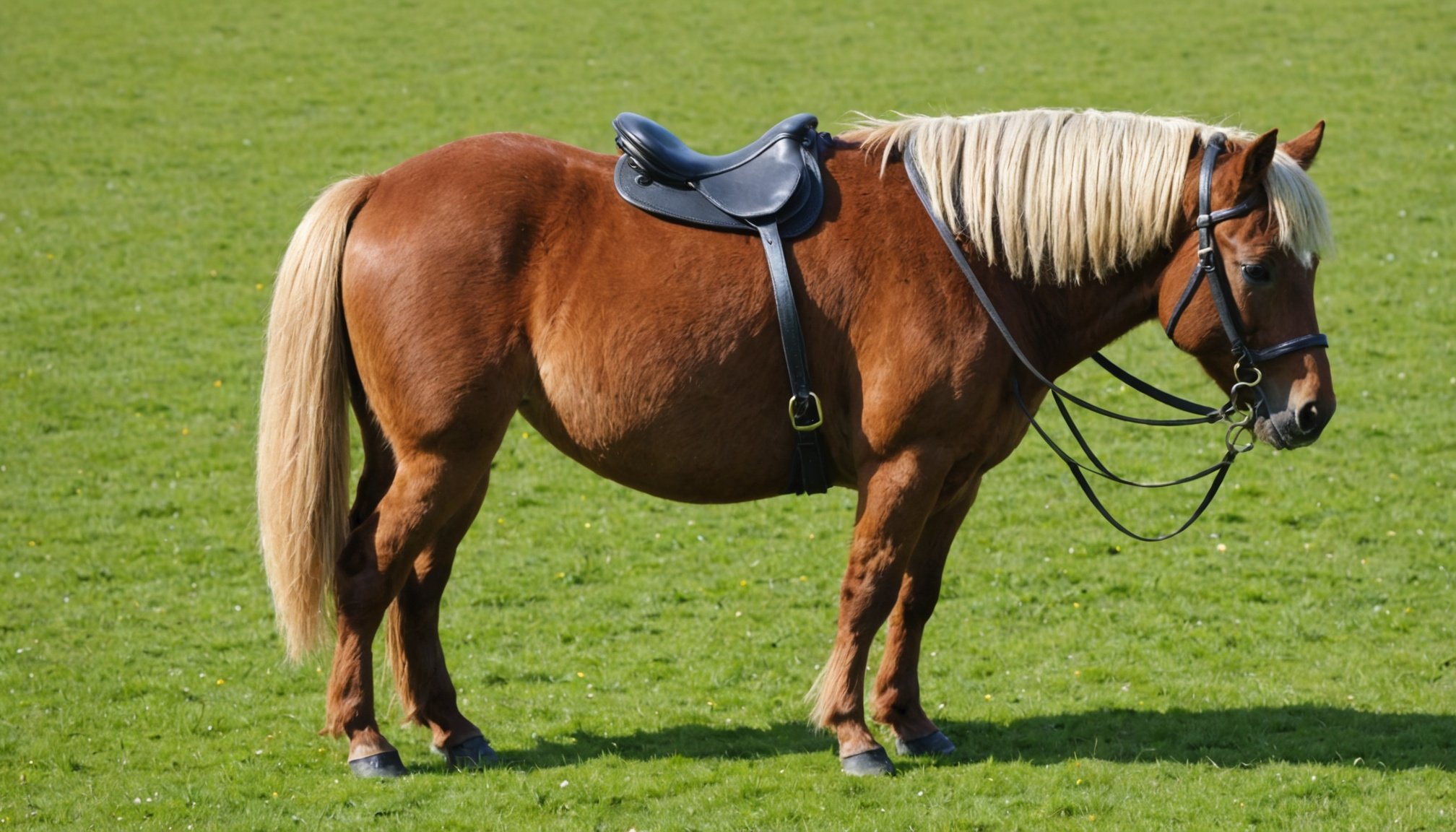Understanding Saddle Sores in Shetland Ponies
Saddle sores are a common concern in equine health, especially concerning the care of Shetland ponies. These sores are pressure-induced skin abrasions that occur underneath a saddle due to friction or ill-fitting equipment. Recognizing and addressing these is crucial for maintaining the health and comfort of your Shetland pony.
Various factors can increase the risk of saddle sores in Shetland ponies. Due to their small stature, improper saddle size can lead to uneven weight distribution, exacerbating pressure points. Moreover, inadequate padding that fails to protect sensitive skin further contributes to the development of sores.
A découvrir également : Designing the perfect diabetic diet plan for your jack russell terrier: key tips and strategies for success
Early identification of symptoms is paramount in Shetland pony care. Look for signs such as redness, swelling, or heat in areas where the saddle rests. Timely intervention can signify the difference between simple preventative care and a lengthy recovery process. Maintaining vigilant equine health involves routine checks and adjustments to saddling practices, ensuring a comfortable ride for your pony.
Addressing saddle sores promptly mitigates discomfort and upholds robust equine health, paving the way for a rewarding relationship with your Shetland pony.
A lire aussi : Exploring the special health challenges of scottish fold cats and their unique ear structure
Preventive Measures for Saddle Sores
Proactively addressing saddle sore prevention can enhance your riding experience and comfort. A well-fitted saddle is crucial, as an ill-fitted one can cause friction and pressure, leading to soreness. Consider the shape and size of the saddle, ensuring it aligns with your body to distribute weight evenly.
Consistent grooming routines are essential in maintaining skin health. This includes cleaning the area where the saddle contacts to prevent dirt and sweat build-up, which can exacerbate irritation. By keeping the skin clean and dry, you can significantly reduce the risk of developing painful sores.
Furthermore, adjusting your riding habits is a viable prevention strategy. Variations in posture and movement can alleviate constant pressure on specific points. Regularly shifting your weight in the saddle helps in promoting better blood flow and alleviates pressure areas that might result in soreness.
Collectively, these strategies—selecting a properly fitting saddle, maintaining a disciplined grooming routine, and adapting your riding habits—form a comprehensive approach to preventing saddle sores effectively. Understanding and implementing these measures can lead to a more enjoyable and pain-free riding experience.
Identifying Symptoms of Saddle Sores
Recognizing the symptoms of saddle sores in horses is crucial for early intervention and treatment. Saddle sores not only cause discomfort but can also lead to more severe health issues if not addressed promptly.
Physical Signs to Watch For
Physical indicators are often the first signs of saddle sores. Observe for any skin abrasions, redness, or swelling under the saddle area. These physical symptoms can often indicate friction and pressure, common causes of sores.
Behavioral Changes Indicative of Pain
Horses might show behavioral changes indicating pain from saddle sores. Look for reluctance in being saddled, changes in gait, or irritability. These subtle cues can signify underlying discomfort due to sores.
Importance of Regular Inspections
Regular inspection of your horse’s back can help identify symptoms early. Here’s how to inspect effectively:
- Remove the saddle and check for signs of abrasion.
- Feel for any heat or swelling in the area.
- Note any muscle twitching when touched.
By keeping a record of any changes observed during inspections, you can better track your horse’s health and address symptoms promptly. Recognizing subtle changes in behavior and conducting regular inspections are pivotal in ensuring your horse’s well-being.
Treatment Options for Saddle Sores
Finding the right treatment for saddle sores is essential to hasten the healing process and alleviate discomfort. A thoughtful, step-by-step approach ensures effective care.
Steps to Manage Saddle Sores
- Identify the Cause: Begin by assessing cycling habits or equipment that could be contributing to the issue.
- Cleansing and Resting: Gentle cleansing of the affected area with mild soap and water is crucial. Allow the sore to air dry. Prioritise rest and limit activities that exacerbate the condition. This reduction in pressure is vital for healing.
- Topical Treatments: Consider using over-the-counter options like antibiotic ointments or barrier creams to protect the area and minimise infection risk. Popular choices include zinc oxide or petroleum jelly-based creams that soothe and protect delicate skin.
- Medications: In more severe cases, consult a healthcare professional who might recommend medications or more robust topical treatments to hasten recovery.
Importance of Rest
Rest is fundamental in the healing process. Reducing activity and allowing the skin time to repair itself can drastically lessen recovery time. Care tips such as maintaining skin hygiene and avoiding tight clothing can prevent further irritation, promoting quicker healing.
Grooming Techniques to Prevent Saddle Sores
Maintaining optimal skin care and cleanliness is essential in preventing saddle sores in horses. Grooming is not only about appearance; it plays a vital role in equine hygiene.
Best Grooming Practices
To effectively protect your horse against saddle sores, focus on these grooming techniques:
- Cleanse the skin thoroughly to remove dirt and sweat accumulation, particularly in the saddle area.
- Use gentle brushes and mitts to avoid irritating the skin.
- Inspect and trim the coat to help spot early signs of irritation or sores.
Recommended Products for Skin Care
Incorporate products that boost hydration and protection into your horse’s routine. Opt for high-quality shampoos and conditioners that are formulated for sensitive skin. Apply soothing balms to areas prone to friction, ensuring these regions remain supple and resilient.
Frequency of Grooming Sessions
Establish a grooming schedule that adheres to your horse’s specific needs. Routine grooming sessions can not only maintain a healthy skin and coat but also help in identifying any early signs of discomfort. A regular schedule nurtures a comfortable environment for your horse, reducing the possibility of developing saddle sores. By prioritizing equine hygiene, you protect the horse’s comfort and well-being.
Case Studies and Testimonials
Real-life examples from pony care testimonials offer valuable insights into successful recovery stories. Take the case of Misty, a delicate pony who faced laminitis. Her owner’s attentive care and commitment resulted in a remarkable turnaround. The process involved tailored exercise regimens and a revamped diet, illustrating the importance of individualized care plans.
Such case studies shed light on crucial lessons learned. One key takeaway from these stories is the significance of early intervention, which can drastically alter outcomes. Proactive monitoring and swift action can often prevent minor issues from escalating into serious health problems, as seen in several testimonials.
Further, these experiences highlight practical tips for preventing future issues. Owners recommend regular health check-ups and mindful observation of behavioural changes. Diligent attention to nutrition and exercise stands out as a recurring theme in pony care advice shared.
By learning from these real-life examples, other pony owners can adopt beneficial practices that promote longevity and well-being in their own ponies. Sharing these stories fuels a community where knowledge and experience enhance overall care standards.











